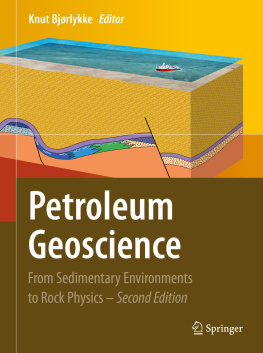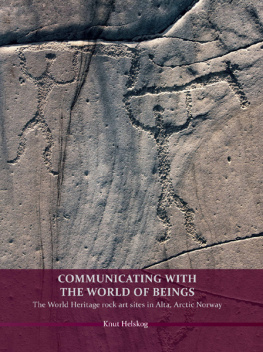1. Introduction to Petroleum Geology
Petroleum geology comprises those geological disciplines which are of greatest significance for the finding and recovery of oil and gas. Since most of the obvious and easy to find petroleum already has been discovered it is necessary to use sophisticated methods in the exploration of sedimentary basins. These include advanced geophysical techniques and basin modelling. There is also much more emphasis now on enhanced recovery from the producing fields. Petroleum technology has made great progress and many new tools and modelling programs have been developed, both in exploration and production.
It is however important to understand the geological processes which determine the distribution of different sedimentary rocks and their physical properties. This knowledge is fundamental to being able to successfully apply the methods now available.
It is difficult to know where to start when teaching petroleum geology because nearly all the different disciplines build on each other.
This introductory chapter will provide a short and rather simple overview of some aspects of petroleum geology to introduce the subject and the problems. Most of the other chapters will then expand on what is presented here to provide a better background in relevant subjects.
Since practically all petroleum occurs in sedimentary rocks, sedimentary geology forms one of the main foundations of petroleum geology. Sedimentological models are used to predict the location of different facies in the sedimentary basins, and from that the likely presence of source rocks with a high content of organic matter, reservoir rocks and cap rocks. The distribution and geometry of potential sandstone or carbonate reservoirs requires detailed sedimentological models, and sequence stratigraphy has been a useful tool in such reconstructions.
The biostratigraphic correlation of strata encountered in exploration wells is achieved by micropalaeontology (including palynology), a field developed very largely by the oil industry. Due to the small size of the samples obtained during drilling operations one cannot rely on macrofossils; even in core samples the chance of finding good macrofossils is poor. By contrast a few grams of rock from the drill cuttings may contain several hundred microfossils or palynomorphs which are small remains of plants such as pollen, spores etc. These also usually provide better stratigraphic resolution than macrofossils.
Reservoir rocks are mostly sandstones and carbonates which are sufficiently porous to hold significant amounts of petroleum. The composition and properties of other rock types such as shales and salt are also important.
The sedimentary environments (sedimentary facies) determine the distribution of reservoir rocks and their primary composition. Sediments do, however, alter their properties with increasing overburden due to diagenesis during burial.
Diagenetic processes determine the changes in porosity (compaction), permeability and other physical properties such as velocity, in both sandstone and limestone reservoirs. Chemical processes controlling mineral reactions are important.
Organic geochemistry , which includes the study of organic matter in sediments and its transformation into hydrocarbons, has become another vital part of petroleum geology.
Tectonics and structural geology provide an understanding of the subsidence, folding and uplift responsible for the creation and dynamic history of a basin. The timing of the folding and faulting that forms structural traps is very important in relation to the migration of hydrocarbons.
Seismic methods have become the main tool for mapping sedimentary facies, stratigraphy, sequence stratigraphy and tectonic development. Marine seismics recorded from ships have become very efficient and seismic lines are shot at only a few 100 m spacing or less. Because of the rapid improvement in the quality of seismic data processing techniques, geological interpretation of seismic data has become an important and expanding field. Seismic and other geophysical data are often the only information we have, particularly for offshore exploration where drilling is very costly. Shooting seismic lines with a close spacing allows high resolution 3D seismic imagery to be produced for critical parts of sedimentary basins. By repeating a 3D reservoir seismic survey during production, one can observe how the gas/oil and oil/water contacts move as the reservoir is depleted. This is called 4D seismic because time provides the fourth dimension.
Geophysical measurements may include gravimetry and magnetometry; electromagnetic methods that were used mostly in ore exploration have also in the last 1020 years been applied to oil exploration. Electromagnetic methods have been used to detect sediments with low resistivity due to the presence of oil instead of saline water. This method requires a few 100 m of water depth and relatively shallow accumulation (<23 km).
Seismic surveys are more expensive on land than by ship at sea because geophones have to be placed in a grid, often on uneven and difficult land surfaces. Drilling on land, however, costs much less than from offshore rigs and a much denser well spacing can be used during both exploration and production.
Indirect methods of mapping rock types employing geophysical aids are becoming increasingly important in petroleum geology, but it is still necessary to take samples and examine the rocks themselves. A petroleum geologist should have a broad geological training, preferably also from field work.
Geophysical well-logging methods have developed equally rapidly, from simple electric and radioactive logs to highly advanced logging tools which provide detailed information about the sequence penetrated by the well. Logs provide a continuity of information about the rock properties which one can seldom obtain from exposures or core samples. This information makes it possible to interpret not only the lithological composition of the rocks and the variation of porosity and permeability, but also the depositional environment. Image logs make it possible also to detect bedding and fractures inside the wells.
Practical petroleum geology is not only based on many different geological and geophysical disciplines. A good background in basic chemistry, physics, mathematics and computing is also required, particularly for different types of basin modelling.
A very large percentage of the geologists and geophysicists in the world are directly or indirectly involved with the petroleum industry which recruits a large percentage of the university students in relevant fields.
The petroleum industry also funds much research which is not narrow applied research, but more general contributions to the understanding of the Earths crust and particularly sedimentary basins. Applied research directed towards exploration and production of oil and gas has often resulted in insight into more fundamental geological processes.
Environmental geology has become a very important field to deal with problems not only related to the petroleum industry but generally about the distribution of pollutants in rocks and sediments.
A good background in chemistry is then required.
1.1 A Brief Petroleum History
There are many places where oil seeps out of the ground. Bitumen produced from such naturally occurring crude oil has been collected and used since ancient times, both for lighting and medicine, and by the Greeks even for warfare. In some places, for example Germany in the 1800s, small mines were dug to get at the oil. Before 1859 oil was also recovered from coal for use in kerosene lamps. It was not until Edwin Drakes exploits in 1859 at Oil Creek near Titusville in West Pennsylvania that oil was recovered in any quantity from boreholes. He drilled a well about 25 m (70 ft) deep which produced 810 bbl/day, a huge production rate compared with anything earlier. A few years later there were 74 wells round Oil Creek, and the USAs annual production had risen to half a million barrels. Outside the USA the calculated total production at that time was maximum 5,000 bbl. In 1870 production had increased tenfold, with 5 million bbl from the USA, and 538,000 bbl from other countries. In southern California oil production started early in 1864 (in Santa Paula), but for many years oil was mined by driving shafts into the oil-bearing strata because it was so heavy and biodegraded that it would not flow in a well.








